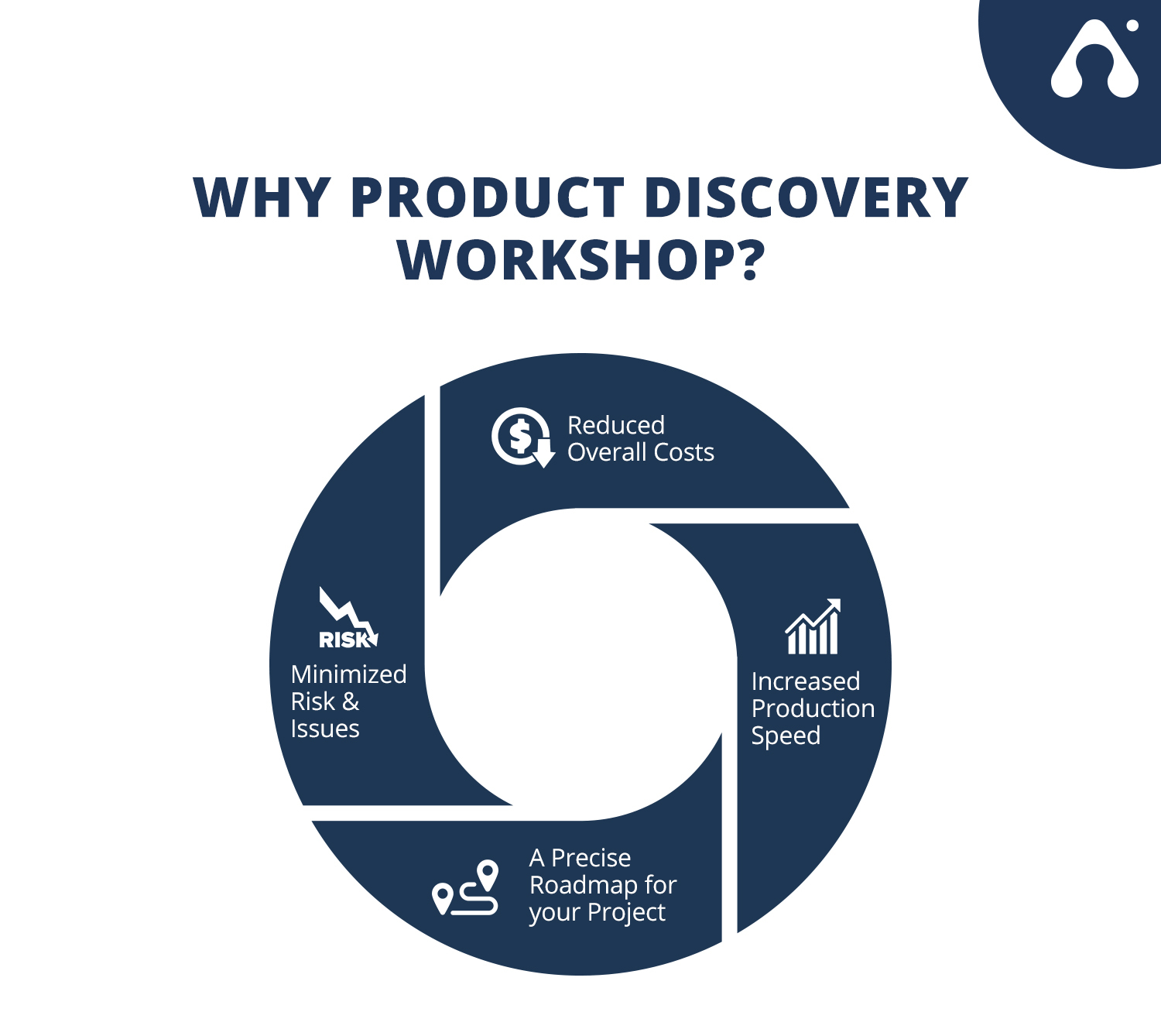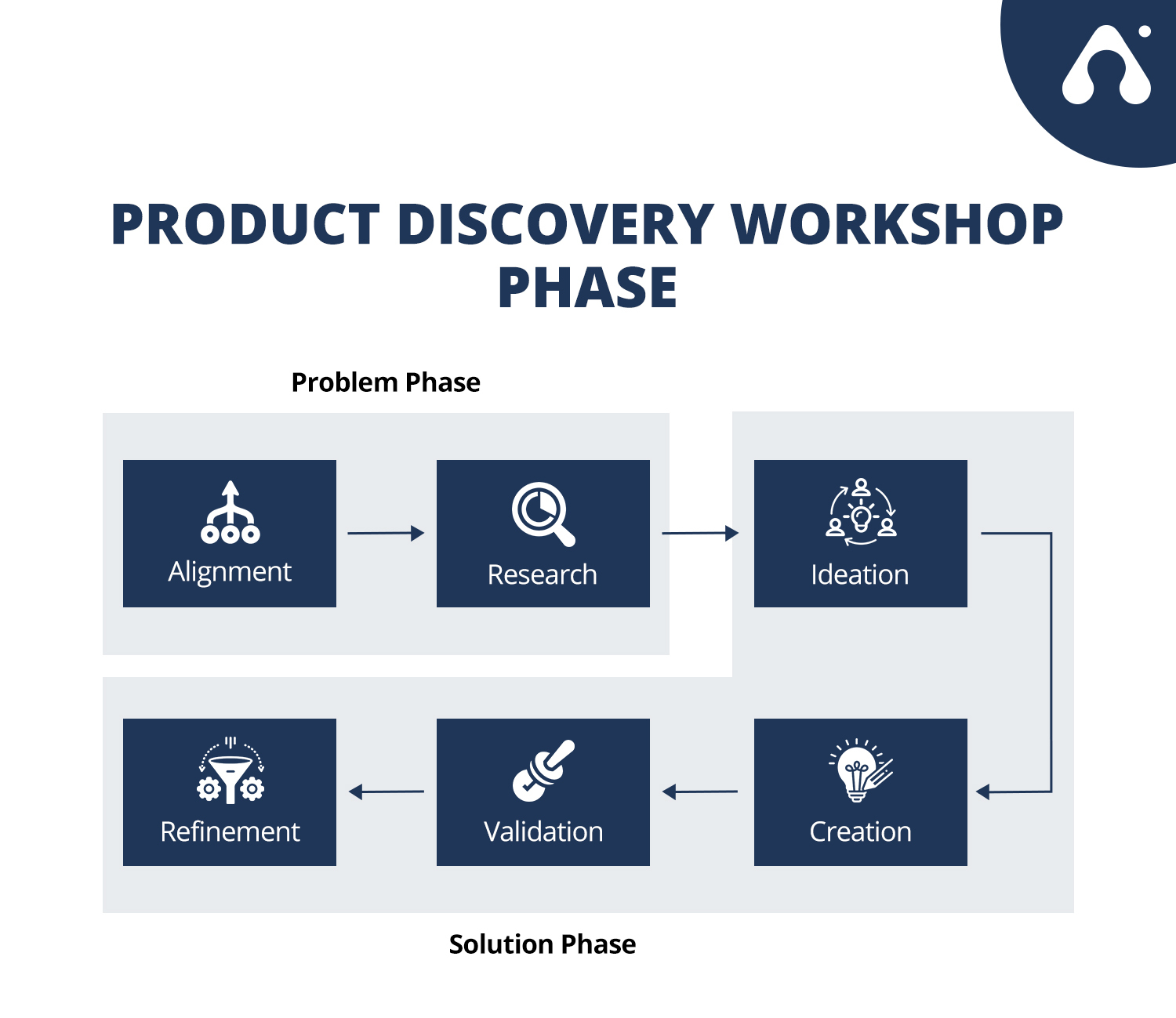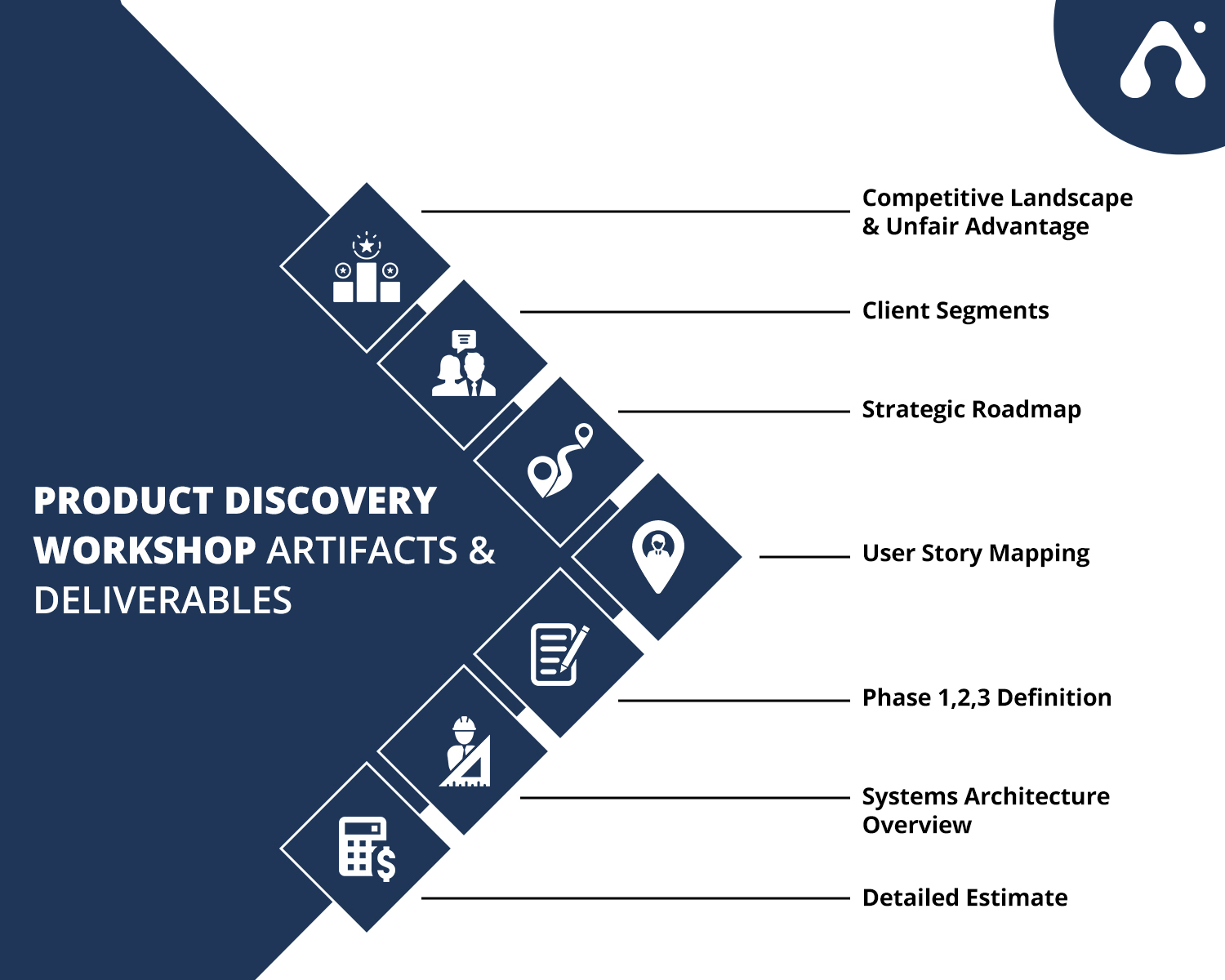Those days are gone when a great idea was enough for software product development and an empty garage for an office space. Nowadays, besides great ideas, you need sound evaluation, proper design and strict planning to create a great product. Whether it’s customized software for a large organization or a mobile app that connects businesses […]
Updated 22 February 2024

CEO at Appventurez
Those days are gone when a great idea was enough for software product development and an empty garage for an office space. Nowadays, besides great ideas, you need sound evaluation, proper design and strict planning to create a great product. Whether it’s customized software for a large organization or a mobile app that connects businesses to consumers or other types of digital solutions, every project needs to be properly scoped and defined before starting any production. That’s where a product discovery workshop comes into the picture.
A Discovery workshop is especially important to establish your business around a specific digital solution when you are in the startup phase. The right way to start developing your digital product depends on the knowledge and experience of those who build software projects regularly. So, make sure you have complete knowledge of the product discovery workshop before starting working on this phase. In this guide, you will understand everything essential for starting a successful software project. Let’s first start with a software discovery workshop introduction.
A software discovery workshop is the most important step in any software development process. It allows you to handle any project efficiently. During this phase, you define the project’s basic goals and requirements such as budget, staff, and functional specifications, including tech stack, end-user platform, logistical expectations and more. It is a planning phase in the mobile app development lifecycle, wherein both parties build a shared understanding and mutually agreed upon the strategies to resolve a specific issue.
A product discovery workshop sets up the project team and provides the opportunity to mutually explore the scope of an idea and guide the project in the right direction. By the end of this process, we highlight business goals and streamline the entire development process. Engaging in a discovery workshop helps predict fundamental enterprise app development challenges. It is conducted with the main aim of evaluating the project’s scope. Here are some objectives that are significantly essential for the project’s success.
Whether you are a startup that wants to rapidly launch an MVP (Minimum Viable Product) in the market or an established company looking to tap into new features or launch new software, a discovery workshop is the right choice!
No matter the project size, a product discovery workshop works for everyone. However many think of skipping the workshop when building a small product. Even with standard or minimum functionality in a discovery workshop, you can find new frontiers and develop a product efficiently.
When it comes to handling large and complicated projects, a product discovery workshop plays a vital role! But why? There are many reasons behind it, including defining every element, all the relevant information regarding the project, assessing the work scope for every phase, and streamlining the entire project at once. Large projects imply more problems and you can resolve potential challenges starting through a discovery workshop.

Let’s understand the reasons for following discovery workshop for a successful project:
Undoubtedly money is known as the ultimate factor when it comes to android or iOS app development projects. Several variables can affect the final cost of building a product, and specific features and functionalities affect it the most. Once you have conducted a product discovery workshop, you will know which features will be implemented when and in what way.
Defining a list of features vital for your software to achieve its goal and eliminate unwanted errors in the workshop’s main goal. By doing that, you can reduce all unnecessary development costs.
One of the most common reasons a software discovery workshop is an important phase for software app development. During this phase, the clients and the project team identify the potential issues and risks and create solutions. Hence, it ensures minimized risks and that there are alternative plans in case a problem arises.
Defining a complete list of features and functionalities for your software during the product discovery phase, you can focus on the project timeline. It enables you to create very detailed timelines and take periods of doing nothing completely out of the picture. A couple of days of investment in the workshop and consulting can save you weeks in the long run because, during the workshop, you will:
It will help you save time in the software development process.
After conducting the software discovery workshop, you will get extensive documents with other essential aspects to start your project. It also helps attract investors and secure funding if you are in the startup phase of developing your business. This phase acts as a blueprint describing your entire project in detail and as a structured plan essential to build and release your software successfully. If you want a visual communication tool that aligns your business around high-level mobile app development strategies, an accurate product roadmap is the right choice!
Many people think of switching this phase of the software development life cycle as there are many reasons to conduct product discovery workshops. But did you know skipping this phase can be risky for your business? Yes, this is true! So,
Starting your software development project off right is a factor that can make or break your complete software development process. By doing a discovery workshop at the beginning, you can get many benefits in the long run. If you think of jumping straight to implementation without following the product discovery phase, you can face potentially dire consequences later on. Here are some risks you can face if you decide to skip the workshops:
Never think your idea is simple. A common mistake every person makes when developing a product is assuming that as your solution seems straightforward, implementing it will also be so. But the fact is that the more clear your idea is, the easier it is to underestimate your project implementation costs. That’s why many projects end up unfinished and wild: running out of money to complete the work.
Simplicity is one thing, but you can’t deny the underlying technology and mobile app development technologies essential to bringing your product idea to life. The digital product landscape is getting more complicated these days. The only way you can properly assess your project is to support someone familiar with the business, design, and development.
Unfortunately, funding is not the only problem you may experience. Even if you have enough capital to invest in your product, there’s still a chance you won’t find anyone to sell it. The software usually suffers from a lack of users when the ideas aren’t validated upfront. To estimate your solutions correctly, you should consider;
Both are essential to see, especially if there is money to be made from your product implementation. Make sure you define your idea precisely and get it ready for market validation. Point to be noted; the discovery workshops don’t contain market validation. Instead, Appventurez helps you specify your ideas and possibly suggest a way to validate them through a prototype or an MVP. But how to overcome these issues?
Here are some steps you can follow to overcome the issues with software discovery workshops:
Verifying your business needs and goals is the first essential step to resolving the problems with the software discovery workshop process. Make sure you cover all the bases here and look at this from every essential angle. Even when all the parties included agree, inconsistencies between the plans and expectations of different stakeholders often come to light later on in the software development process. Make a clear plan from the start lest you end up with inadequately designed and developed software.
After defining your business goals properly, it’s essential to know how your potential products align with your goals to serve their purpose. This is where a real product’s functionality needs to be derived from your ideas. Simultaneously, substantial knowledge of developing software is required here. Not only is the idea testing stage a part of the implementation. During this phase, you also need to:
You may find that your scope needs adjusting or your product won’t be profitable, as the implementation costs far exceed the potential profits.
Last but not least, software discovery workshop phases should give you a visual representation of your product’s potential. Having your deliverables visualized is a perfect way to tell your idea in story form, making it easier for you to express both your concept and your assumptions to the clients. After visualizing your potential product, you can consider transforming your idea into a clickable interface prototype; however, building a prototype doesn’t happen during the discovery phase as it is a different product. The wireframing and prototyping services are the next step of the process that lets you further validate your product and helps you attract seed investors. Your investors will expect a solid business plan from you along with a chance to see how the suggested functionalities would work immediately: A prototype is perfect for that.
The main benefit of having a prototype is verifying your basic product idea with potential users. Whether you plan on using your product or selling it on the market, getting feedback on the features from your end-users is vital to unlocking the true potential of your product.
Now, it’s time to move towards an adaptable product discovery approach.

Like many things in an Agile environment, the product discovery phase is not a linear process. However, it is perfect to follow a specific approach to move in the right direction. A product discovery process looks like a holistic approach, such as framing an issue, finding possible solutions and aligning your team. When making product discovery, you can always go back to the previous step and take a different route altogether. But, for structuring your ideas, you must set apart the entire process into phases.
Here are six Phases of a Software Development Project:
To make a successful product, you need to build a shared understanding among the key stakeholders or product team’s decision-makers – Alignment. Project managers usually organize a startup meeting which is also known as a kickoff meeting. While explicitly scheduled to discuss the project need and set apart what each one of the stakeholders knows about the product, it follows:
As per the project complexity, the duration of the meeting setup can vary. While it can last just a few hours if the project has low or medium complexity, it can even take many days for such complicated projects. As the Alignment phase includes many stakeholders, the product manager’s responsibility is to keep product management aligned among team members included in the project. Instead of finding a viable solution, stakeholders should focus more on defining the real issues and understanding the users facing them.
The research phase includes going out and collecting data to test whether our assumptions are right or wrong. For user research, the mobile app development team can use different tools to collect user feedback in an organized way, helping reveal the actual user needs. The team can conduct user interviews, observation studies, surveys, and competitor research to execute the research process as per the product type.
The user research phase includes many steps:
In this phase, you can start moving towards the solution space. Now, you know your user’s issues, you can move forward to find ways to resolve these issues. Consider scheduling a meeting with all project stakeholders to present the data gathered and solutions to resolve the issue. But, try not to throw everything you have gathered to the team in one go. You can place the same ideas in a similar bunch by structuring the entire ideation process for a better organization. Your team members can then vote for their favorite idea and the most voted should be given priority.
At this stage, you should focus on what features will make your product more useful. So, by the end of this phase, you must have your product’s vision and objectives clear. Prepare the first organized version of the gathered information and start sketching the ideas.
It is time to build different affordable and simple versions of your product with specific features. You can test these prototypes within a team from outside. It is an experimentation stage, and you can’t create the actual end product here. Finding the best possible solution to the issues identified earlier. You will have to implement solutions within the prototypes and test whether they are acceptable, need any improvement or are rejected based on their user experience. By the end of this stage, the design team will have a clear view of how a real user would interact and feel when using the end product. Here are some tips for better executing discovery prototyping:
During the idea validation phase, you can finalize whether the product design idea is worth spending your resources, time and money on. While this phase relates to different user research phases, at this point, you have a viable solution in your hands.
You must consider validating your ideas and solutions from different angles and using different methods for better results. For example, you can use A/B testing, user interviews and surveys to ensure users react to your product. Although using different approaches to validate your idea, make sure to stay true about the Signal strength. It shows how reliable your outcomes are and helps you make the right decision.
For making a useful product, it’s essential to move back and forth and align your user’s needs with your business goals. If you successfully validate your idea, you will collect data to build a Minimum Viable Product for startups in this stage. On the other hand, if your idea falls in the validation test, you may have to take steps back to the research phase to find out what went wrong. In this journey, the next step after this stage is going to be product delivery. So, you must have a set of validated assumptions and ideas before moving to the next phase.
In addition, team members usually have the results of all the above phases messily. The main task your product team requires at this stage is to organize the data as per the processes and guidelines of your company. For a better structure, break the validated ideas into a bunch, prioritize them, and plan the development team. Also, software product discovery artifacts and deliverables are shown in the figure below:

Hopefully, you have now understood everything about the software discovery workshop to start your project successfully. Whether you are an innovative start-up looking to develop your initial product or an existing company looking for new mobile/web app development or adding new features to an existing one, you can get in touch with a reputed mobile app development company!
At Appventurez, we have many years of experience in delivering reliable and successful software development solutions. As a reliable software development company, we follow reliable design and product discovery workshops that include participation from relevant client stakeholders and our dedicated team of experts, including user experience designers, software engineers and project managers.


Elevate your journey and empower your choices with our insightful guidance.

CEO at Appventurez
Ajay Kumar has 15+ years of experience in entrepreneurship, project management, and team handling. He has technical expertise in software development and database management. He currently directs the company’s day-to-day functioning and administration.
You’re just one step away from turning your idea into a global product.
Everything begins with a simple conversation.